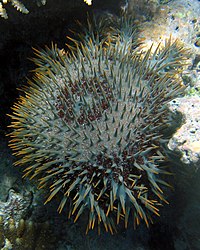
Quantifying shedding and degradation rates of environmental DNA (eDNA) from Pacific crown-of-thorns seastar (Acanthaster cf. solaris)
Sign Up to like & getrecommendations! Published in 2021 at "Marine Biology"
DOI: 10.1007/s00227-021-03896-x
Abstract: Population outbreaks of the corallivorous crown-of-thorns seastar (CoTS; Acanthaster spp.) are significant threats to the Indo-Pacific reefs. Although recent research demonstrated that environmental DNA (eDNA) techniques could improve CoTS monitoring, the interpretation of surveillance results… read more here.
Keywords: crown thorns; environmental dna; thorns seastar; rate ... See more keywords

A Crown-of-Thorns Seastar recombinant relaxin-like gonad-stimulating peptide triggers oocyte maturation and ovulation.
Sign Up to like & getrecommendations! Published in 2019 at "General and comparative endocrinology"
DOI: 10.1016/j.ygcen.2019.05.009
Abstract: The Acanthaster planci species-complex [Crown-of-Thorns Seastar (COTS)] are highly fecund echinoderms that exhibit population outbreaks on coral reef ecosystems worldwide, including the Australian Great Barrier Reef. A better understanding of the COTS molecular biology is… read more here.
Keywords: gonad stimulating; relaxin like; crown thorns; like gonad ... See more keywords

Bias associated with the detectability of the coral-eating pest crown-of-thorns seastar and implications for reef management
Sign Up to like & getrecommendations! Published in 2017 at "Royal Society Open Science"
DOI: 10.1098/rsos.170396
Abstract: Outbreaks of the predator crown-of-thorns seastar (COTS) Acanthaster planci cause widespread coral mortality across the Indo-Pacific. Like many marine invertebrates, COTS is a nocturnal species whose cryptic behaviour during the day can affect its detectability,… read more here.
Keywords: reef management; crown thorns; day; thorns seastar ... See more keywords